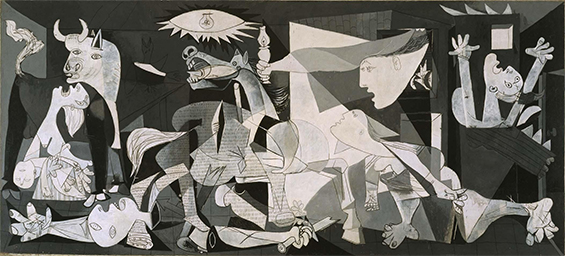Guernica
Pablo Picasso's Guernica is one of the singular most famous paintings in the world. Its timeless quality makes it universally relevant in past, present and future situations. Guernica's complexities and hidden messages mean that it can be returned to time and again and you will still not have seen it all.
Picasso painted the enormous mural in 1937 after the Basque town of Guernica was bombed by the Germans on April 26th of the same year. The devastation of the town killed and injured over 1600 people and the brutality and injustice of the incident immediately struck a chord with Picasso. He had already completed his commission for the Paris International Exhibition, a painting of a bull fight, but he was quick to change his plans, and pressed for the opportunity to depict the recent events in the Basque Country.
Guernica was born out of his strong emotions and he began to work on it immediately after the event had happened, making the relevance powerful and the significance strong as everyone was still recovering from the shock of the bombing.
It is hard to define the significance of Picasso's Guernica - it is, more or less, what you make of it as the viewer. Whilst the painting spurned from the bombing of Guernica, it is clear that Picasso is appealing to a more general perception of war. In his typically Cubist syle, he deconstructs and reconstructs his figures so that they become representations of a feeling, as opposed to specific beings. Suffering, death, fear, war, devastation and even the tiniest bit of hope are represented as universal themes which will hold eternal relevance.

Guernica appears to be set in a room as an eye shaped lightbulb illuminates the scene, however this could be seen to represent anything from the sun to the governing powers of the war. We then have several human figures including a wounded soldier clutching a broken sword, a woman cradling her dead child, a woman who appears to be floating, a woman on fire and a woman fleeing the scene. However, the most famous image in the painting is that of the horse in agony which stands directly beneath the lightbulb. There is also a bull which is very emblematic of Spain and a dove with a broken wing.
When we look closer at the painting hidden human skulls can be found and things are not quite as they seem. The disjointed parts of each figure can be viewed alone or collectively, each time changing one's perception of what is actually going on in the painting.
Picasso's choice of monochromatic black, white and grey-blue serves to blur the boundaries even more, as well as recalling the idea of a newspaper photograph. This is important as Picasso was in Paris when Guernica was bombed and found out about the incident from a newspaper article - it suggests that these were the images which sprang to mind when he learnt about what had happened.
Guernica was an immediate show-stopper and people all over the world were able to relate to Picasso's tormented scene. Whilst he actually stated in his will that he wanted the painting to be displayed in Madrid's Prado Museum, in 1992 it was moved to the nearby Museo Nacional Centro de Arte Reina Sofia where it remains today. Here you can also see a huge number of sketches done before Picasso painted the main mural, which allow us to see how the images took shape and really enrich one's perception of Guernica.




